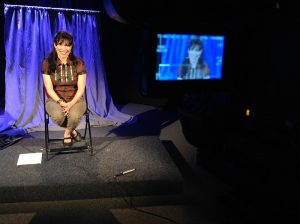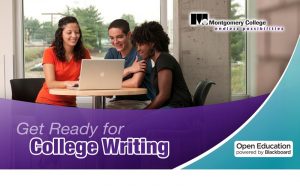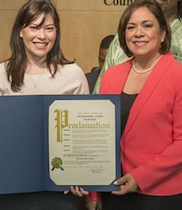Reflections on Montgomery College’s MOOC
By Emily Rosado
Why a MOOC?
In the Fall 2013 semester, I had the privilege of teaching Montgomery College’s first ever Massive Open Online  Course (MOOC), Get Ready for College English. It was the first MOOC offered by a community college in the state of Maryland. The idea for this project was born out of conversations between the Office of E-Learning, Innovation, and Teaching Excellence (ELITE) and me about ways to use innovation to address some of the issues we are facing in higher education, including how best to provide Open Educational Resources (OERs), how to help more students place into credit-level English, and how to provide more students (and potential students) a risk-free online learning experience. A MOOC seemed like the perfect platform because anyone and everyone with access to a computer and the Internet could engage in a rich learning experience with no prerequisites or fees.
Course (MOOC), Get Ready for College English. It was the first MOOC offered by a community college in the state of Maryland. The idea for this project was born out of conversations between the Office of E-Learning, Innovation, and Teaching Excellence (ELITE) and me about ways to use innovation to address some of the issues we are facing in higher education, including how best to provide Open Educational Resources (OERs), how to help more students place into credit-level English, and how to provide more students (and potential students) a risk-free online learning experience. A MOOC seemed like the perfect platform because anyone and everyone with access to a computer and the Internet could engage in a rich learning experience with no prerequisites or fees.
MOOCs are college courses taught fully online, offered at no charge with unlimited enrollment. As part of my preparations to teach this course, I enrolled in a course offered by Coursera called The Social Context of Mental Health and Illness. Being a student in a MOOC was an eye-opening experience. I was able to experience a different pedagogical style, which helped me to reflect on different aspects of my own course delivery, including information presentation and forms of feedback. Along with 26,000 other students, I engaged in lessons consisting of video lectures, PowerPoint presentations, outside readings accessible via the web, and YouTube videos. It was fascinating to learn such interesting and relevant information from an expert in the field, and all it cost me was my time. It was time well spent, and it inspired me to offer other eager students – students who may not otherwise be able to pay for a course – the chance to learn how to be a more confident writer, a necessary skill in today’s global workforce.
Building the Course, One Step at a Time
Our intention was to provide access to a writing prep course to anyone who could possibly benefit from one. The intended audience included current Montgomery College students across all disciplines. We also targeted  Montgomery County Public Schools high school students who needed to strengthen their skills to place into a credit-level English course once they start college. Other groups in mind included those serving in the military who didn’t have access to a college campus but could get online, and adjunct faculty looking for resources to help them teach their developmental or English 101 courses. Once I had a target audience in mind, I started to build the course from scratch.
Montgomery County Public Schools high school students who needed to strengthen their skills to place into a credit-level English course once they start college. Other groups in mind included those serving in the military who didn’t have access to a college campus but could get online, and adjunct faculty looking for resources to help them teach their developmental or English 101 courses. Once I had a target audience in mind, I started to build the course from scratch.
Because MOOCS, by nature, are free of cost, any and all materials in the course had to either be original or available on the Internet. We decided on an eight-week format consisting of weekly video lectures, reading assignments, and writing assignments. Student interaction was to take place on the discussion board, and the readings chosen centered on human rights issues across the globe and were conducive to strong and opinionated reactions. All content was new and built specifically for this MOOC. Over a five-month period in the spring of 2013, I wrote scripts for all of the video lessons, gathered the reading assignments, and built an online template in the Learning Management System (LMS). That summer, I recorded the videos over a six-week period in the Montgomery College Television studio with the help of MCTV staff. Recording consisted of an on-camera introduction for each week, followed by a voiceover lesson with text on screen. I also recorded a separate series of grammar lessons that students could use at any time throughout the course. Countless hours of work resulted in an eight-week writing course that was truly accessible to all.
The Pilot
By the Fall 2013 semester, we were ready to pilot the MOOC. To our surprise, participants began to enroll as soon as we opened registration. Many of the initial enrollees were students from abroad who were non-native English speakers who wanted to practice their language skills. Enrollment continued to climb, leveling out at just over 700 students from 81 different countries. Locally, participants included current Montgomery College students, MCPS high school students, local home-schooled students, members of the community, and even MC staff. To help build community, I created a Facebook group page for the course, and within days, close to 100 students joined. Every week was structured the same way. There was one lesson per week, consisting of viewing the video lecture, annotating the reading assignment using a four-step approach, responding to readings on the discussion board, and writing a journal entry that prompted students to reflect on various aspects of their writing for that week. Weekly metacognitive assignments trained students to think about their writing and articulate their process. On the discussion board, students would respond to each other’s posts and offer “graded” peer reviews on longer writing assignments. Scaffolded activities led to full essay assignments. Simple but detailed rubrics were provided so students felt comfortable assessing their peers’ work. All assignments were pass/fail, and students earned a certificate of completion if they completed 70 percent of the assignments. In addition to being a sequential course taught by an instructor, one of the main goals of the MOOC was to create OERs that faculty could use to supplement their face-to-face classes.
I was thrilled that some of my colleagues reported that they used parts of my course in their face-to-face classes. I also had my developmental students become MOOC learners. This was a multipronged experiment because many of them had never taken an online class, and this was a great way to introduce them to it. Likewise, it was a seamless way to expose my students to a variety of perspectives from other learners across the globe. Many of them, born and raised in Maryland, were intrigued that they were engaging in discussions with students from Afghanistan, Nigeria, Russia, Mexico, China, and other places that seemed worlds away. Also, since my in-class students were a few weeks ahead of the participants in the MOOC, I was able to guide them into offering constructive feedback to their peers, furthering the depth of their learning. Through their interactions with MOOC participants, students learned lessons about netiquette, tone, voice, and clear and understandable writing – all skills that they will continually practice in future studies and in the workforce.
The Second Go-Round
 For the second run of the Get Ready for College Writing MOOC in the Fall 2014 semester, we had more targeted groups of students in mind. Outreach targeted MC faculty, MCPS students, and community residents. While the pilot benefited from a fair amount of local and national press, there was less fanfare the second time around, but we still pulled in just over 200 students.
For the second run of the Get Ready for College Writing MOOC in the Fall 2014 semester, we had more targeted groups of students in mind. Outreach targeted MC faculty, MCPS students, and community residents. While the pilot benefited from a fair amount of local and national press, there was less fanfare the second time around, but we still pulled in just over 200 students.
Instead of offering the course as eight lessons to be taken in sequence, we opened all eight modules from the beginning and incorporated badges into the course. This way, students could pick and choose which module(s) to complete based on what they needed help with the most in order to tailor their learning experience. Each module was equipped with a “badge” that would be available after the assignments were completed. A student could earn a badge for the thesis statements lesson, for example, and have something to show for the work that he/she did. The idea of having students facilitate each other’s learning while broadening their own perspectives remained constant, and we engaged in many lively discussions throughout the course.
Reflections
Completing this project from start to finish was exhausting yet truly rewarding. Positive feedback from students and colleagues and unwavering support from administration kept me motivated to give these students 110 percent. One of the things that I learned from teaching this MOOC is that it’s difficult to define success in this kind of medium. For the second offering, we had 207 students, but only about 12 participated regularly. Of the 12, six completed every single module and worked really hard to express their opinions in discussions and improve their writing. All of them wrote to me after the course was over, thanking me for all of the valuable feedback I had provided and for teaching this course with warmth and positivity. For me, this was success even though just a small percentage completed the course. Two other things about teaching the MOOC stood out to me as being different from teaching a regular online class. First, I was writing a course with no idea of who my audience would end up being. This was a challenge, but it forced me to make sure that everything from the design of the modules to my pacing on camera was crystal clear and as easy to understand as possible. Second, the diversity of students involved in the MOOC truly enriched the learning experience for everyone involved. One of the assignments asked students to discuss their perceptions of veteran care in their countries, and the information shared was poignant and more meaningful than anything we could read in a textbook. In this way, the MOOC learners shared in the teaching of the course and offered insight that the instructor could not otherwise provide from firsthand experience. MOOCs create a unique community of voluntary learners that would be difficult to replicate in a traditional classroom.
What’s Next?
The MOOC is not running this semester since I am on sabbatical and working on some other exciting projects for ELITE. I hope that the course continues to be useful for faculty across disciplines who encounter students who need to strengthen their writing skills. Most recently, I’ve been contacted by faculty in New Zealand who would like to use my lessons to help their students with study skills and by the University of New Mexico, which is interested in having its non-credit students take my course. I’m truly grateful to have had this rewarding opportunity to do something innovative for the College and to show the world that Montgomery College is a global force in giving students access to quality education.
 ( Emily Rosado, left, receives a proclamation from the Montgomery County Council. Councilmember Nancy Navarro is on the right. Rosado also received the MDLA Individual of the Year Award and was a finalist in the American Association of Community Colleges Faculty award for Innovation for her work on this project.)
( Emily Rosado, left, receives a proclamation from the Montgomery County Council. Councilmember Nancy Navarro is on the right. Rosado also received the MDLA Individual of the Year Award and was a finalist in the American Association of Community Colleges Faculty award for Innovation for her work on this project.)


